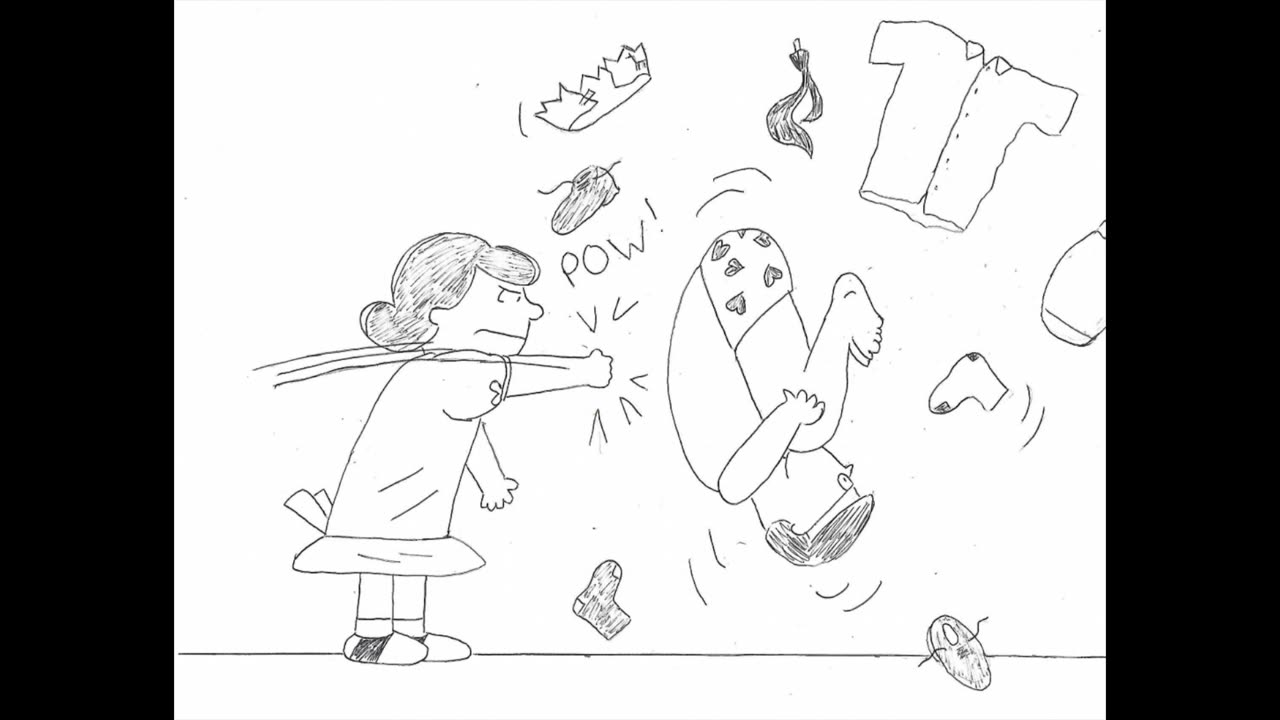Premium Only Content

Meandering Story Time with Uncle Rebus
This sketch was inspired by a visually-oriented troupe member of ours who has a bit of a picturesque fetish, with his first exposure to rebuses through reruns of the game show “Concentration.” This sketch was also inspired by the awful “reimagined” trend in the world of entertainment. When we here at CoBaD see the phrase “reimagined fairy tale,” what we see is just a superficial makeover of a classic tale; the hero or heroine is given a different skin color, the fairy tale has a different setting and everybody talks in slang. Not quite as superficial as, say, a “modernization” of an opera (where the libretto and music are the same and only the setting and costumes have changed) or minimalist settings (both alluded to in the “Daydream Bleacher” sketch). Nevertheless, “reimagined” just seems to us as a cheap politically correct marketing tool intended to appease demographics and make money off of them, kind of like the “Stock Market” skit, where a man takes a tired old concept (an interview show) to a network executive and scams the executive into buying it by dressing it up to appeal to her money-making tastes. In this adaptation of Sleeping Beauty, though, the changes go a bit deeper. True, there are physical changes, albeit very subtle (Sleeping Beauty’s race is not specifically identified, but we think of her as Hispanic). However, it’s really the self-centered foibles of a spoiled vainglorious diva with a “Riding off into the Sunset Happily Ever After” agenda that ultimately powers this locomotive of a fairy tale, assisted by the ever passive-digressive narrator Uncle Rebus, who, acting as conductor of this runaway train of thought, drives it over gorge-like plot holes, navigates it heroically through rabbit holes and eventually steers it stoically off the rails.
Uncle Rebus, the narrator, was inspired from watching children’s story time television shows. We have noticed that the hosts of these shows tend to speak slower and enunciate every syllable and introduce a slight pause between each word, rather than when that same person talks to an adult, when they run the words together (conversation rate of speech which is between 120-150 words per minute). We understand the principle behind it; keeping kids engaged. That works great for one-on-one story telling or even telling stories to a classroom of kids. In both scenarios, there is a two way interaction. Where that theory breaks down is when story telling becomes a one way line of communication (like in a television show). Without the advantage of “reading the audience,” you are left with a narrator speaking at the same unhappy medium rate of speech the whole time, losing the kids who think you are talking too fast and boring the kids who think you’re talking too slow. Story telling shouldn’t have a “one size fits all” approach; rather, it should be individually tailored to the needs of the kids, and that can only be accomplished through interpersonal experience.
“Sleepy” picture – Taken at the famous "Sleepy" sign near the top of Mount Seeply, the picture is of Felix Mendelssohn and Karl Klingemann. For more on these two folks, see “Abstain Your Enthusiasm” sketch.
Still photo of Sleeping Beauty as a young girl – The Dragon Kennel Club is an obvious send up of the American Kennel Club. One of our troupe member had a mother who showed dogs to judges who wore ugly plaid sport coats. She showed them by running them round and round in circles, secretly hoping that during the competition she didn’t throw up from motion sickness or from looking at his hideously ugly sport coat for too long. She wanted her son to participate in the American Kennel Club Junior Showmanship program, but, unlike Sleeping Beauty, he was too lazy to participate. Officially known as conformations, the dogs are judged as to how closely they conform to the ideal standards of a particular breed. Our favorite award was the giggle-inducing “Best Bitch” prize (i.e., award for the best female dog). Sleeping Beauty’s “Best Supporting Bitch,” prize, however, is an award that goes exclusively to handlers, a competition that, based on hearsay, was far more competitive and far more fun.
Sleeping Beauty morphing from the Evil Queen from Snow White into Lucy from “Peanuts” – A tribute to Charles Schulz’s classic comic strip. The sketches make references to all the quirks we’ve seen from the famous strip: Frieda has a hook nose (vice a bulbous nose like most of the other characters), Violet wears Mary Jane shoes, Lucy wears saddle shoes, and all the characters have parentheses surrounding her eyeballs whenever they’re surprised, worried or angry. In addition, Prince Charming gets curled up into a ball by an uppercase POW delivered by Sleeping Beauty, Prince Charming’s clothes come off like Charlie Brown’s does whenever Charlie Brown is hit by a line drive, and Prince Charming and Sir Don-DeRoad-Star (in admittedly a frame-saving exercise and in an effort to simulate animation in a still picture) showcases multiple heads to indicate that several characters are trying to gain his attention at the same time.
Uncle Rebus: “Prince Charming responded to Sleeping Beauty’s request for action in two parts. First, by claiming that his performance specifications explicitly state that he is to kiss Sleeping Beauty, not Little Red Riding Hood, and second, that smooching a dragon was definitely out of scope, and that carrying out such a task would require a contract mod…”
Defense contract rubbish. Inspired by the definition of the term “performance specifications” from the 1995 Performance Specification Guide:
“In general, specifications communicate the user’s requirements to the manufacturer. They translate operational requirements into more technical language that tells the manufacturer: 1) what we will consider an acceptable product, and 2) how we will determine if the product is acceptable. To the extent that any specification does these two things, it is good. The problem arises when we use specifications to tell the manufacturer how to make the product.” (p.4)
“A performance specification states requirements in terms of the required results and provides criteria for verifying compliance, but it does not state methods for achieving results. It defines the functional requirements for the product, the environment in which it must operate, and the interface and interchangeability requirements.” (p.6).
Holy, Creeping Beauty, Batman, she’s out of scope!
Caption: "How about that? Don-DeRode-Star was right! He does have four mouths to feed!" - For more on Don-DeRode-Star and his four mouths, see "The Diplopian War" sketch.
Incidentally, notice that the spelling here is different from Don-DeRoad, the Chief Deafening Officer in the "Better Translate than Never" sketch. Over the centuries, the Don-DeRode family changed the spelling of its name from the 11th century "DeRode" (as in "he rode a horse") to the modern day "DeRoad" (as in "to kick the can down the road") to suit their respective times and occupations. Although we here at CoBaD suspect that the real reason is that the family does not have a Quality Assurance focal on staff.
Swan Lake picture - A reference to Peter Ilyich Tchaikovsky’s “Swan Lake.” We were quite impressed with this “reimagining” of Tchaikovsky’s classic ballet. Where in the world did those dancers find pointe diving boots? And they danced so elegantly in them! Bravo!
The “Danger Shallow End” sign is a reference to the great ballet dancer, Anna Pavlova. This actually alludes to her five minute ballet solo choreographed in 1905 by Mikhail Fokine called “The Dying Swan.” Danced to Camille Saint-Saëns’s “Le cygne (The Swan) a movement from “The Carnival of the Animals,” she allegedly performed this solo over 4,000 times, making it (much to her delight) her signature piece. Not related to “Swan Lake,” but we just wanted to squeeze her name in here because we like her.
Spirit of Sechsundsiebzig scene - For more on this sketch which Prince Charming crashed, see the “Bach’s Diversified Portfolio / Spirit of Sechsundsiebzig” sketch.
Governor Bellingham: “Now I don’t know about you, Chairman Rosie, but I have a, uh, cameo appearance on this island, and, uh, in my eternal struggle of liberty against tyranny, and in concert with all the free nations of this hemisphere and my puppet masters in the CIA, must make a uh, preemptive move with my mismanaged undermanned army, haphazard air cover and botched communications and defend my lines on the beaches of Cuba!” – A reference to a speech made by John F. Kennedy’s Bay of Pigs speech on April 20, 1961. Planned by Dwight David Eisenhower (who apparently wanted to relive his glory days from the beaches of Normandy) and executed by John F. Kennedy, the Bay of Pigs stands John F. Kennedy’s finest shining turd of failure as U.S. president.
Prince: “Hey! Now you guys are eating into my cameo! (turning to Reek) So, anyway, Mr. Reek, you say you wrote ‘Here Comes the Bride’ huh? Okay, I’ll take a chance and assume you can play it.” – Inspired by the surprising fact that composer don’t always perform or conduct the premiers of their pieces. We here at CoBaD think that “a captain should go down with his ship” rather than have someone else take on the rotten fruit and vegetable onslaught, but ultimately it’s the composer’s call. So in the end, we can see why a composer thinks that someone else can perform a world premiere of his piece better.
Reek: “You do realize that that piece is from my opera “Lohengrin?” – We were often puzzled why the “Here Comes the Bride” piece is so popular at weddings given its context. Much in the same way we are puzzled by the popularity of “The 1812 Overture” at Fourth of July fireworks displays, as mentioned in the full “Spirit of Sechsundsiebzig” sketch.
Prince: “Now look, Pete, baby…” – A reference to “The Sale of Manhattan” sketch from “Stan Freberg Presents The United States of America” (1961).
Gov. Bellingham: “Now just a minute, who do you think you are? Now let me say this about that! Number one, Prince Annoying, you’re, uh, not an expert on stealing but I am. And you’re filching Stan Freberg material with, uh, with great vigah!” – Governor Bellingham is right, he is an expert on stealing. He just pilfered several lines from Vaughn Meader’s performance as JFK at Boston University in 1962.
Uncle Rebus: “Once upon time there slept a dragon named Maggie.” - A passing reference to two famous Celtic reels, “Sleepy Maggie,” and “Drowsy Maggie,” thus the reason why the kingdoms are named Sleepy and Drowsy, and the dragon is named Maggie.
House for sale picture – A reference to L. Frank Baum’s classic children’s book “The Wonderful Wizard of Oz.” The pictures are the work of W.W. Denslow.
“Coming Soon: Dragon Top Acres, A Brave New World Holding Company” sign – For more on Brave New World Holding Company, see the “Irritable Vowel Syndrome” sketch.
“Dragon Top Acres: Houses by Cookie Cutter Manufactured Homes Co.” – For more on the Cookie Cutter Manufactured Homes Company, see the “Give Mankind Enough Time” sketch.
Picture of man building meditation pond – For more on this man and the woman behind her (Mrs. Detering), see the “Direct and Produce” and “Victory Garden Leave” sketches.
“Houses Built by The Ring Recycle Company, Reek Wagner, Proprietor” - The sign and the names on the trucks are references to Richard Wagner’s “Ring of the Nibelungen” (aka the Ring Cycle). We here at CoBaD were quite surprised to learn that Wagner was a real estate developer. What a shame. Still, it looks like he’s got quite the racket going; selling property to individuals who proceed to build a vast estate, and then, through a web of greed and treachery, turn around and burn it to the ground. Rather clever of Wagner to get a dragon to conduct his demolition work, although unfortunately Siegfried (Wagner’s, not Tchaikovsky’s) didn’t get the memo that you’re not supposed to kill subcontractors.
“This Kind of Hypocrisy” commercial – Pokes fun at the two types of podcasters on Rumble. The first type is the Chicken Little podcasters, who, upon having a nut fall upon their head, through the magic of osmosis, become nuts themselves, and scream at the top of their partisan lungs that the sky is falling. The other type is the crabby fussbudget, who freely engage in name calling and hurling insults much in the same way that the Weimar Republic in the 1920s freely printed out currency which consequently contributed to their hyperinflation, making a truckload full of their work not even worth the price of a freaking loaf of bread.
These particular creators in Rumble have a continuity fluency problem. That is, they are proficient at being inconsistent. Specifically, this ad makes note of the three types of hypocrisy we here at CoBaD see on Rumble, the site where CoBaD posts its sketches. First, the picture is a spoof of the podcast “Chicks in the Office,” a podcast that gossips about celebrity engagements, weddings, etc. Not really our cup of tea, but that’s not the real issue. Where the hypocrisy comes into play is that Rumble has categories to make it easier for users to select the types of videos they want to watch. For some odd reason, the “Chicks in the Office” podcasts are posted under the “Barstool Sports” category, even though their content has absolutely nothing to do with sports. A cursory glance revealed that this isn’t the only non-sports related podcast on Barstool. We can only speculate that Barstool Sports is some sort of media and entertainment equivalent of a real estate developer that’s got an acute case of Sleeping Beauty Scope Creep.
The second level of hypocrisy we see is in the aforementioned Rumble categories themselves. Two of the most popular categories are “Editor Picks,” which are primarily political in nature, where people harp and on about how the military-industrial complex (a term coined by Dwight David Eisenhower, he of Dresden Bombing and Bay of Pigs fame) and the dark state are leading us into one wretched war after another. The other popular channel is “Gaming,” where people, by playing shoot ‘em up war games, build massive armies and vast empires. It’s only when you combine the two categories into one (“Political Gaming”) you soon realize that the dark state doesn’t really hold a monopoly on hypocrisy. Incidentally, the word “socavar” (as in “Dark State: The Legend of Socavar”) is Spanish for “to undermine.”
The third level of hypocrisy is in the Grumble tagline (“Grumble: Your alternative to responsible speech”). This is a passing reference to Father Rod’s chastisement of Rosie in the “Out of Context, Out of Mind” sketch (“There’s a difference between free speech and responsible speech, Rosie!”). The Rumble platform prides itself on being a strong advocate for free speech by not censoring its creators. That’s great, but we wish the creators themselves (specifically those Chicken Littles and Crabby Fussbudgets of the world) would be a bit more responsible in what they say and exercise a bit of self-censoring themselves (vice viewer-boosting self-centering). One popular Rumble creator, for instance, casually throws around the insult “kidf*ckers” whenever he comes across a press release concerning a Democrat or celebrity he hates. Sites such as Rumble claim to defend our rights to express ourselves, but if that self-expression comes in the form of flippantly hurling baseless accusations around like candy and beads at a Mardi Gras parade, then maybe self-regulation isn’t really the answer either. After all, when the booze is free, it’s a wise man who knows when he’s had enough to drink.
References:
Alpha History. John F. Kennedy’s Address on the Bay of Pigs (1961). https://alphahistory.com/coldwar/kennedy-address-bay-of-pigs-1961/
Barnard, D. (8 November, 2022). Average Speaking Rate and Words per Minute Virtualspeech.com. https://virtualspeech.com/blog/average-speaking-rate-words-per-minute
Baum, L. Frank. (2023). The Wonderful Wizard of Oz. Illustrated First Edition. Pictures by W. W. Denslow. SeaWolf Press. First published in 1900.
Office of the Assistant Secretary of Defense for Economic Security (29 June 1995). Performance Specification Guide. Defense Standardization Program, SD-15. Washington, DC. https://apps.dtic.mil/sti/pdfs/ADA297400.pdf
Rebus Club. https://rebus.club/en
Taylor, M. (25 August 2022). How to tell a story to kids (An Expert’s Advice). Repost of “How to Tell a (Good) Story to Kids” by Rebecca Sheir. Imaginationsoup.net. https://imaginationsoup.net/how-to-tell-a-story-kids/
Wikipedia. Anna Pavlova. https://en.wikipedia.org/wiki/Anna_Pavlova
Wikipedia. The Carnival of the Animals. https://en.wikipedia.org/wiki/The_Carnival_of_the_Animals
Wikipedia. The Dying Swan. https://en.wikipedia.org/wiki/The_Dying_Swan
YouTube. Vaughn Meader (as JFK) – 1962 – Standup Comedy. https://www.youtube.com/watch?v=ArKIS5iSp-8
————-
Convulsions of Birth and Death (CoBaD) is a comedy sketch troupe founded in September, 2022 that posts skits on social media covering varied topics such as music, history, art, science, sports, literature and events encountered in everyday life. The title was inspired by Henry David Thoreau’s “Civil Disobedience” (1849), an essay written as a protest against the U.S. government taking his “gift” (i.e., his taxes), and wasting it in ways in which he did not approve (e.g., war and slavery). CoBaD writes sketches in the spirit of Thoreau, but instead of strictly casting its nets outwards towards governments and figures of authority, it projects its protest inwards by taking a humorous, lightheaded look at humanity and specifically those who take the greatest gift of all, life, and senselessly and stupidly waste it on greed, narcissism, self-centeredness, petty-mindedness, arrogance, opportunism, power-grabbing, quid pro quo, the status quo, ulterior motives, and the most despicable waste of all, social media.
-
 47:39
47:39
Michael Franzese
3 hours agoJewelry King Trax NYC EXPOSES How the Powerful Steal from You
32.6K7 -
 LIVE
LIVE
Slightly Offensive
3 hours agoCandace REDPILLS the Masses in BOMBSHELL Theo Von Interview | Guest: Shane Cashman
1,130 watching -
 LIVE
LIVE
megimu32
3 hours agoON THE SUBJECT: IRL Streamers Attacked & Nostalgic Animal Movies That Made Us Cry
338 watching -
 1:00:54
1:00:54
The Tom Renz Show
6 hours agoMore Epstein/FBI, a Scary Trade War, & the Dem Echo Chamber
829 -
 40:43
40:43
Kimberly Guilfoyle
7 hours agoDems Double Down on Delusion-Why? Live with Tony Kinnett & Bo French | Ep.202
61.7K30 -
 1:28:42
1:28:42
Redacted News
5 hours agoBREAKING! SOMETHING BIG IS HAPPENING IN EUROPE ALL OUT WAR IS COMING AGAINST RUSSIA, TRUMP FURIOUS
108K263 -
 47:50
47:50
Candace Show Podcast
6 hours agoBREAKING: Judge Makes Statement Regarding Taylor Swift's Text Messages. | Candace Ep 155
94.3K105 -
 DVR
DVR
Josh Pate's College Football Show
3 hours agoCFB’s Most Hated Teams | FSU & Clemson Future | Big Ten Win Totals | Star Rankings Overrated?
5.76K -
 1:33:47
1:33:47
CatfishedOnline
4 hours agoGoing Live With Robert - Weekly Recap
19.4K -
 55:18
55:18
LFA TV
1 day agoEurope’s Sudden Turn Against America | TRUMPET DAILY 3.6.25 7PM
25.5K3